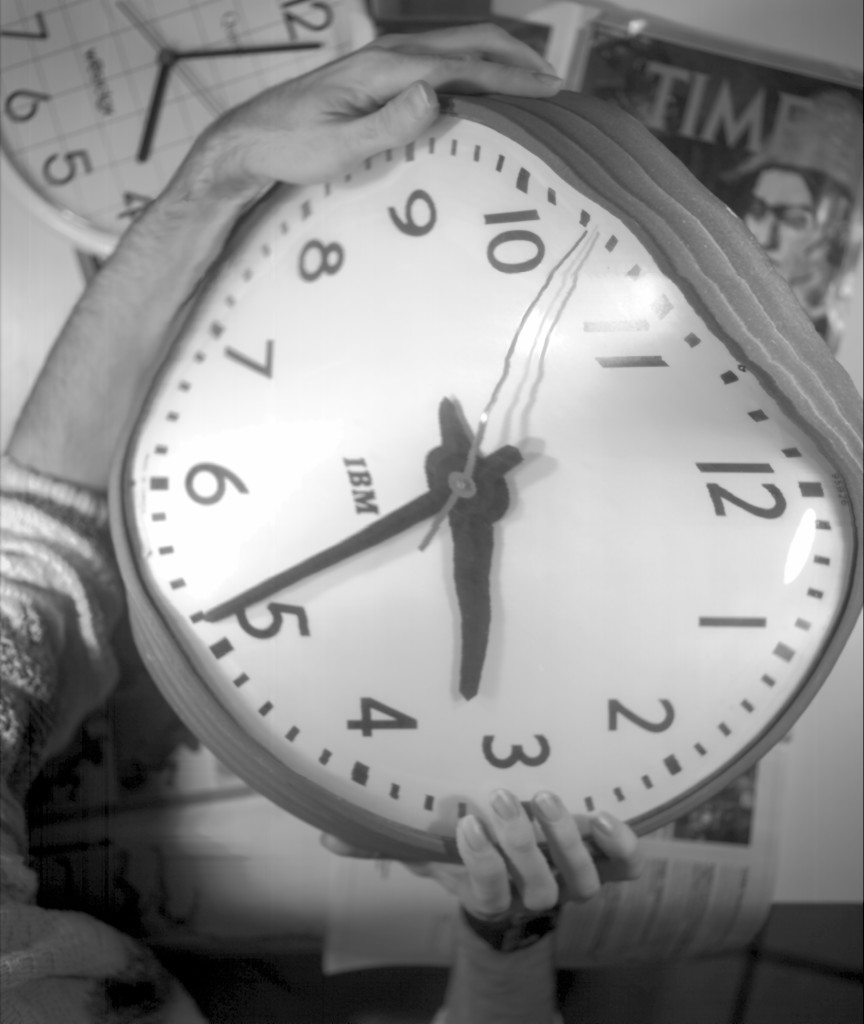
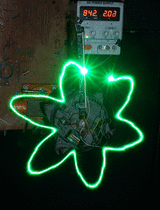
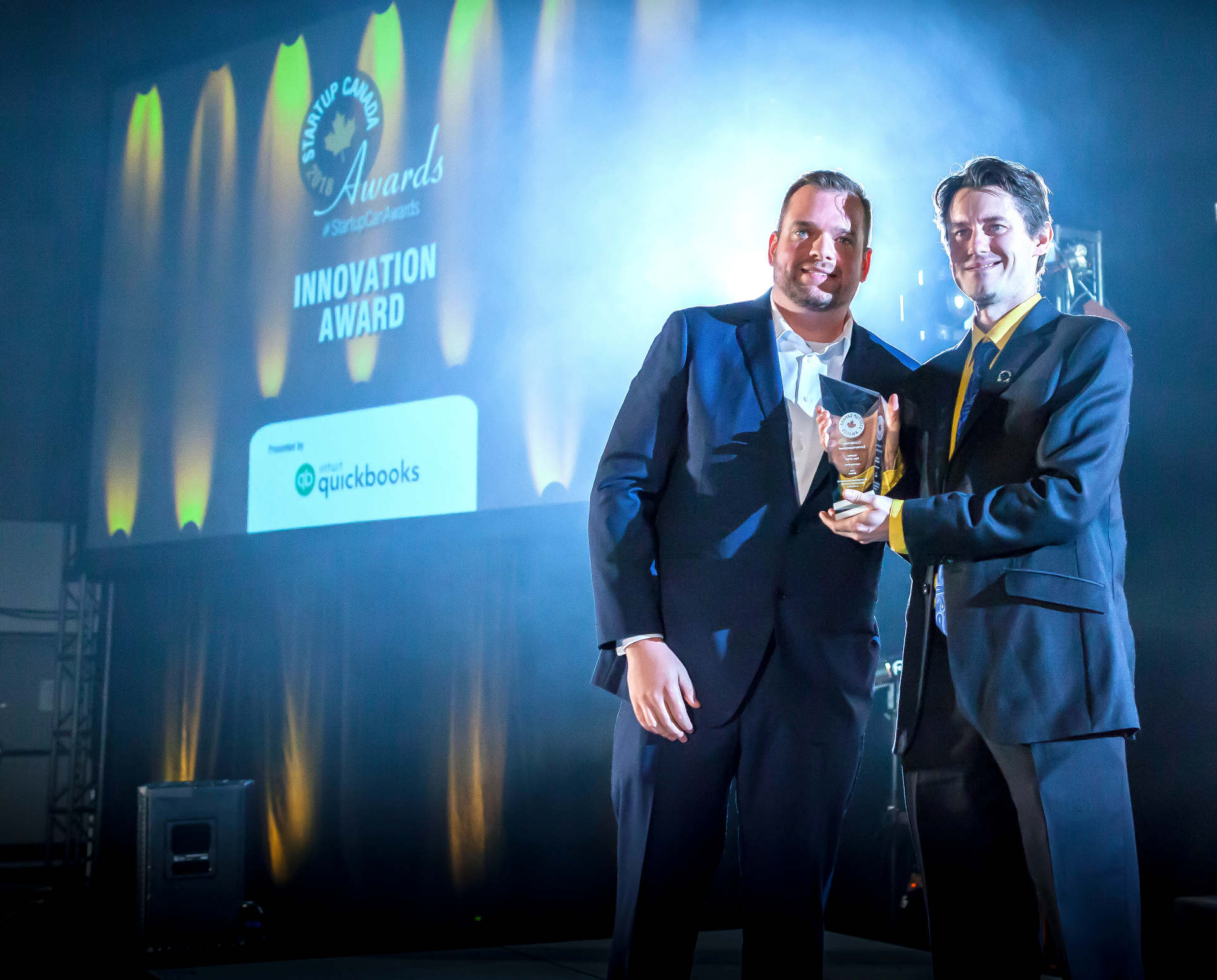
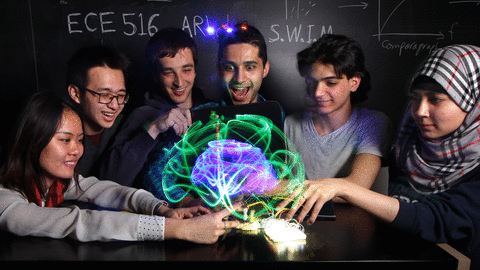
| Schedule | Labs | Philosophy | Opportunities | 20-Year ECE516 History | ||||
 |
 |
 |
 |
"Clothing is a building built for a single occupant, an architecture-of-one, and thus cyborg technology is urban design" -- Steve Mann, MIT Architecture, 1992. [See also Sousveillant Cities and Media, Mann etal, 2018]This course is about mathematics, physics, and engineering, but there is an interesting foundational philosophy behind it, if you care to read more about this (you can skip this section if you just want to get down to the math, physics, and engineering).
The emphasis is on teaching you fundamental physical sciences and engineering so that you can learn how to think (and do) for yourself.
Many universities have become tax-free hedge funds to serve the interests of big corporations and big government. They train students to become a source of cheap labour for big pharma, big data, big science, and big watching (surveillance). They train students to become a small specialized cog in a big machine.
Many courses are no longer taught by professors who are authors of the textbooks or who are authorities on the subject matter, or who even show up to the labs to work directly with the students.
Therefore, what we aim to do in this course is restore the balance in favour of the student, i.e. to empower the student with concepts like "little data" (distributed data like blockchain), "little watching" (also known as sousveillance), and human-in-the-loop AI ("HuMachine Learning") [Minsky, Kurzweil, Mann, 2013].
In this course you will learn how to think for yourself and how to build things yourself without the support of lab technicians and massive infrastructure. These are the skills that startups as well as the top companies are looking for, and certainly the skills you need to create your own startup.
More generally, we need a range of scales from little to big, in all three of these axes.
Some technologies like the bicycle also
work this way. The technology responds to us, and we respond to the technology.
After we've been riding a bicycle for a while, we forget that it is something
separate from our body, and we begin to internalize it as part of us.
Scientist, inventor, and musician Manfred Clynes coined the term "cyborg"
for this special kind of relationship between a human and machine:
There is a symmetry in regards to both the completeness, and the immediacy in
which the bicycle responds to us, and in which we respond to the bicycle. It
senses us in a very direct way, as we depress the pedals or squeeze the brake
handles. We also sense it in a very direct and immediate way. We can
immediately feel the raw unprocessed, and un-delayed manner in which it responds
to us, as well as the manner in which it responds to its environment.
In the future, this concept will expand to include
humans and bicycles with various kinds of sensors and actuators:
Other technologies like the automobile respond to us to even greater degrees.
Just a very light touch on the accelerator and the automobile responds greatly
to that small input from us. And today cars are starting to be equipped
with cameras and other sensors that recognize us and our minute gestures.
Soon cars will even tell when we're feeling a little tired, or if we've
had too much to drink. Some cars keep track of where we go, and even give the
police and insurance companies a recording of our speed and acceleration and
driving history. In this sense, cars are becoming "surveillant systems",
ie. systems that sense us and possibly report us to other authorities.
When our bicycle breaks down, we can understand it and fix it, but modern
cars are a mystery to the average driver. The car knows a lot about us,
but often reveals very little about itself.
Not everyone can, or event wants to, understand everything about how the world
works, but it is in society's best interest if at least some members of the
society can understand how things work, beyond the companies that make them.
When the manufacturer of a technology is the only entity that can understand it,
there is an inherent conflict-of-interest, and an information asymmetry.
And when machines reveal their internal state, they can be trusted more.
Much of the world we live in is being interconnected with technologies that
are surveillant and centralized in nature, but this information flow is
often one-sided. The information assymetry is like a body that has only
(or primarily) a working afferent nervous system, sending signals outward,
but a broken efferent nervous system that can't receive any feedback
signals.
In today's society, we are all potential news reporters. We all have a right (and sometimes even a moral or ethical obligation) to tell our story. Whether a friend or a courtroom asks ``where were you last night?'' we have a right to, if we wish to, show where we were or were not. We might wish to prove we were not at the scene of a crime. Or we might wish to be able to prove we have done nothing wrong.
When those with the authority of surveillance try to prevent sousveillance, we have a potential conflict-of-interest, and thus it is in the public interest to have multiple independent news sources that tell us what happened.
When a North Carolina officer threatened a motorist for recording himself (and the officer), social pressures rightly upheld the rights of the individual to tell his story [North Carolina officer demoted after telling Uber driver/lawyer he couldn't record police, abc7NY WABC-TV, Monday, April 03, 2017].
There is an inherent hypocrisy in "Big Data" and surveillance ("Big Watching") that tries to suppress "little data" and sousveillance ("little watching").
And the opposite of hypocrisy is integrity. Thus big data and surveillance often embody or sustain a lack of integrity. This lack of integrity can be mitigated through the introduction of distributed (little data) technologies like blockchain and sousveillance.
One possible solution is to automate the image capture, so that a
perpetrator triggers the capture, and documents him or her self:
"[T]he personal safety device includes the use of biosensors where the quotient of heart rate divided by footstep rate... provides a visual saliency index. Suppose that someone were to draw a gun and demand cash from the wearer. The likely scenario is that the wearer's heart rate would increase without an increase in footstep rate to explain it (in fact footstep rate would no doubt fall to zero at the request of the assailant). Such an occurrence would be programmed to trigger a "maybe I'm in distress" message to other members of the personal safety network...""Smart Clothing: The Wearable Computer and WearCam", Steve Mann, Personal Technologies, Springer, March 1997, Volume 1, Issue 1.
"Big Watching" (surveillance) is when we're being watched.
"Little Watching" (sousveillance) is when we do the watching:
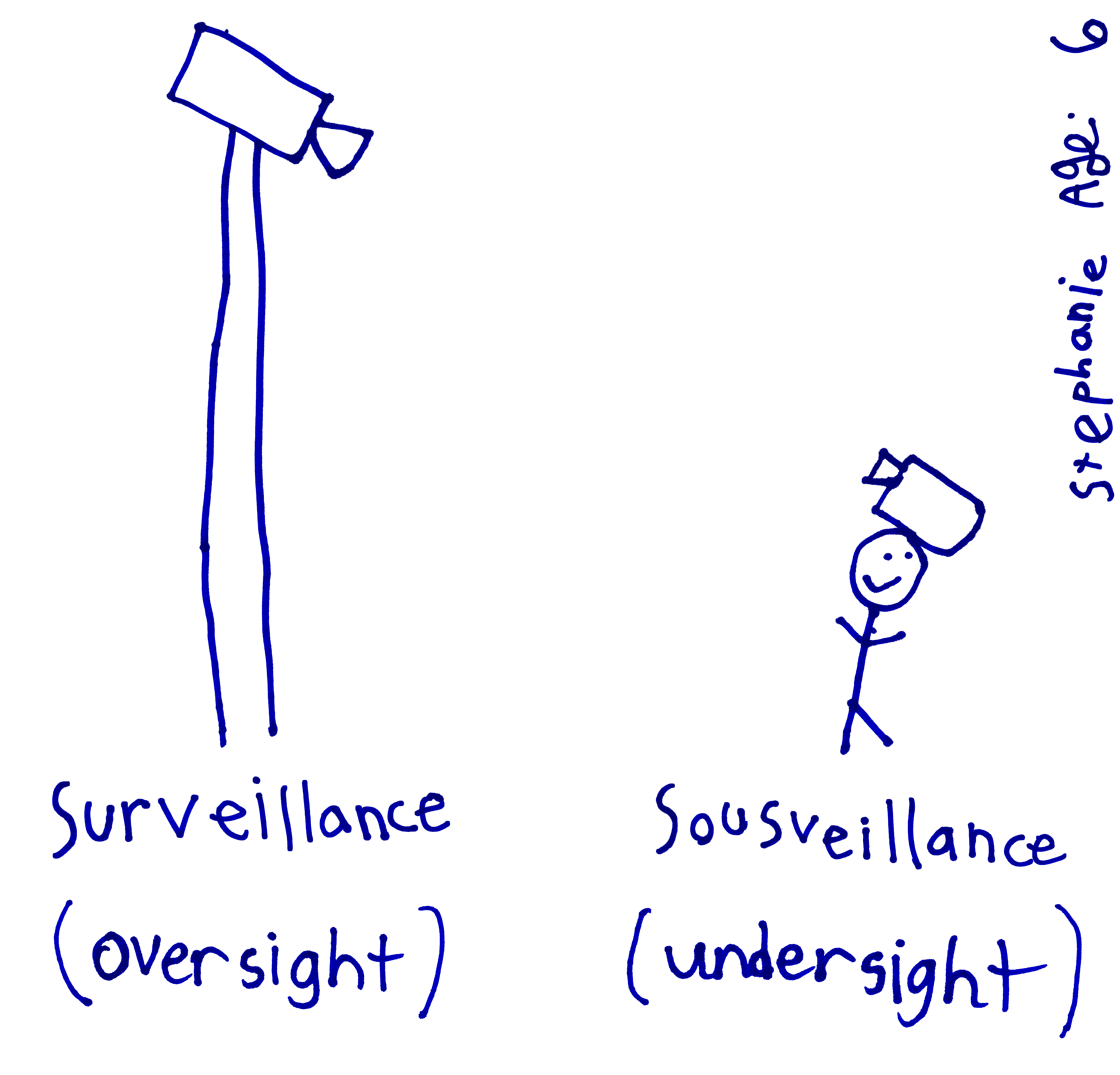
With the rise of AI (Artificial Intelligence), more and more it is machines that are doing the watching, rather than people. Thus the question will no longer merely be whether or not we have the right to record the police, but increasingly, whether or not we have the right (and responsibility) to record (and understand) machines and machine intelligence.
This question is at the heart of what Marvin Minsky (the "Father of AI"), Ray Kurzweil, and Steve Mann refer to as "Humanistic Intelligence" [Minsky, Kurzweil, and Mann, "Society of Intelligent Veillance", IEEE ISTAS 2013, pp. 13-17.]
Humanistic Intelligence is machine learning done right, i.e. where the
machine senses the human (surveillance) and the human senses the machine
(sousveillance), resulting in a complete feedback loop, much like the way
the human mind and body work together, or like a person and a bicycle work
together:
Additionally, the human and machine both sense and affect their surroundings,
so there are actually a total of six signal flow paths.
But the most important ones for our discussion are those that form the
feedback loop between human and machine.
Thus veillance is at the core of HI:
,
and feedback delayed is feedback denied, e.g. delay or reduction in
veillance results in machines that sometimes don't serve humanity:
Thus if we are to have smart buildings, smart cities, etc., serve humanity,
we must balance surveillance and oversight with sousveillance and undersight.
Thus we must design smart cities, sensing, newsgathering, media, and social
media as sousveillant systems in which we can sense the city that senses us
at all levels:
We see here a kind of self-similar (fractal) architecture, from the cells and
neurons in our body, to the microchips in our wearable computers, to the
buildings, streets, and cities, the world, and the universe:
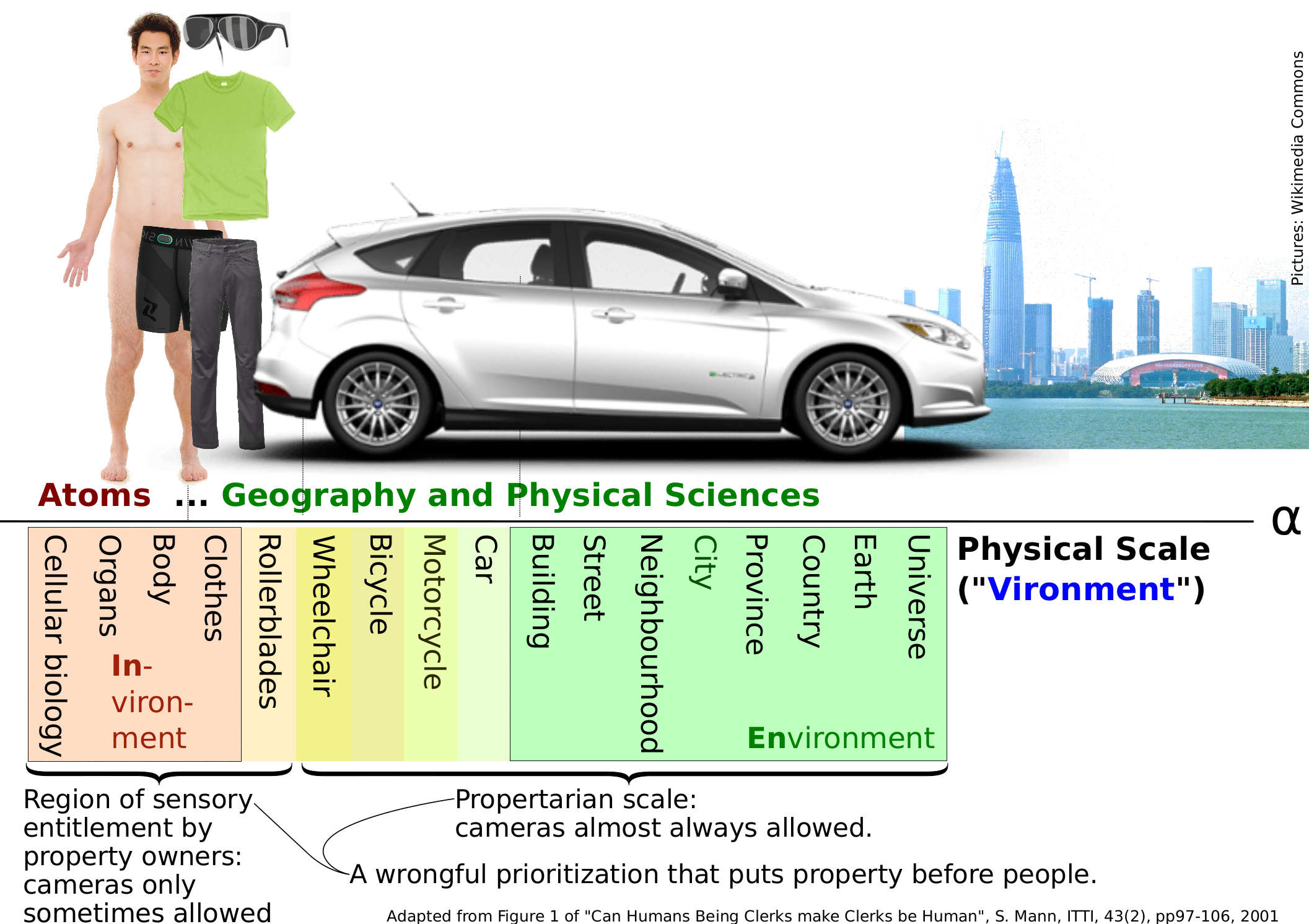 (link to SVG version)
(link to SVG version)
Along with this physical scale (from atoms to an individual human body, all the way out to the edge of the universe), we have also an informatic scale (from "Bits" to "Big Data"), and a human/social scale (from "Genes" to "Bemes" to "Memes"...), sousveillance (little watching) to surveillance (big watching):
We can think of this in a 3-dimensional space:
blockchain ("little data"), wearables, and sousveillance:
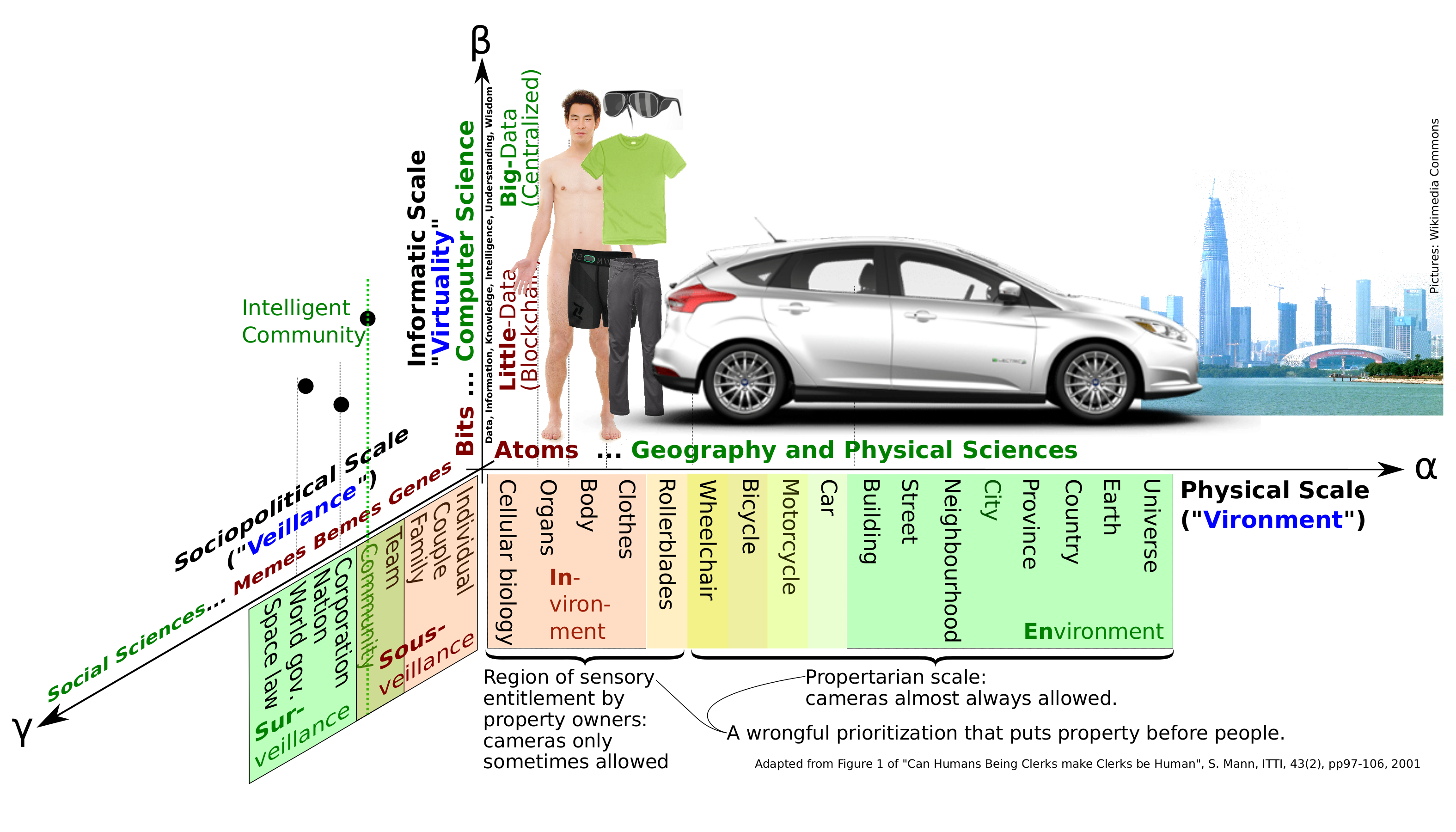 (link to SVG version)
(link to SVG version)
Privacy is often touted as a balance to surveillance,
but when we combine privacy
with surveillance, we get a world in which our neighbours don't see us
but the police and authorities do:
Privacy with surveillance is like the Panopticon prison, in which prisoners' privacy is protected by isolating them from one another, while all remain visible to the guards. This is not true privacy.
Equiveillance is the equilibrium between surveillance and sousveillance, thus forming a foundation for priveillance (central equilibrium point in the diagram).
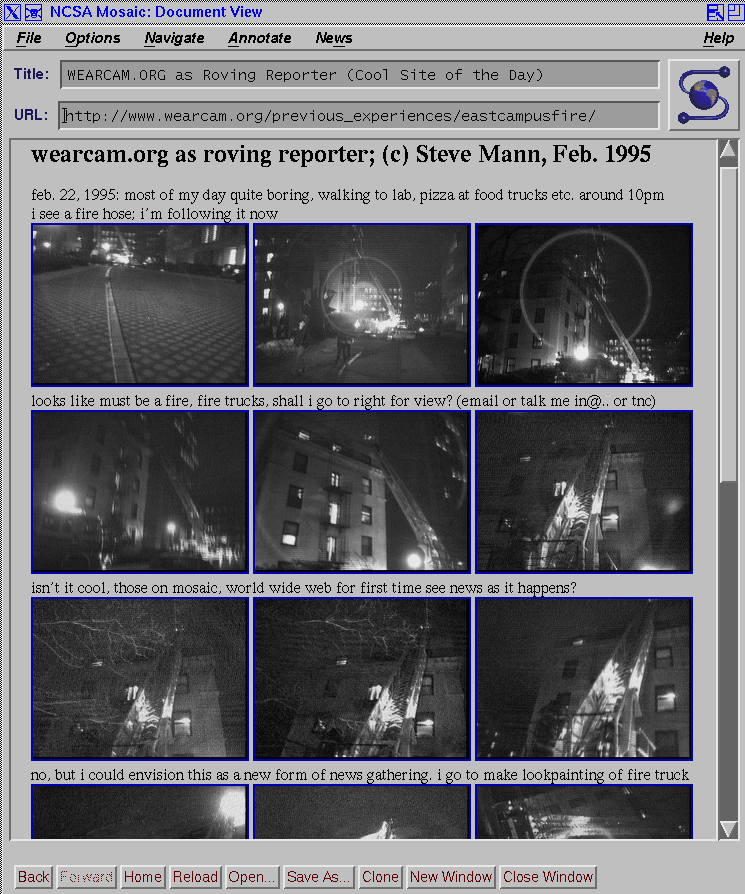
The idea here is to fight fake or biased news by transmitting raw unfiltered news as-it-happens, in realtime, so there is no time or opportunity to "spin" or bias or falsify the news. News reports are cryptographically timestamped and widely distributed.
More recently, we have proposed NEWStamp, a forward AND reverse timestamp,
specifically designed for newsgathering to use blockchain to fight fake news.
NEWStamp works by projecting news items onto the surrounding environment,
and recapturing them using ENGwear (wearable newsgathering technologies):
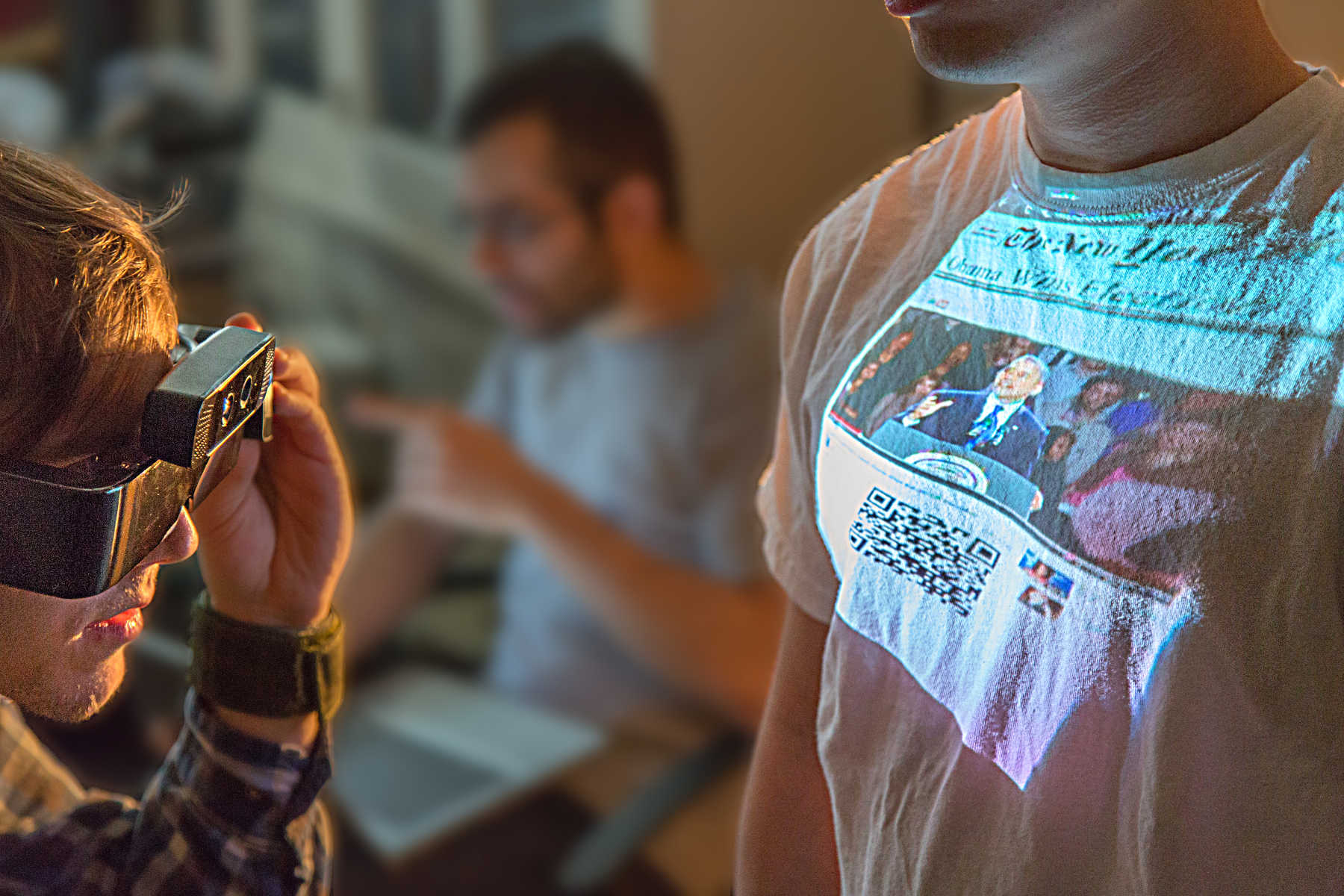 IEEE i-Society, 2013
IEEE i-Society, 2013
Fighting fake news with Blockchain + Wearables + Sousveillance
NEWStampTM system for fighting fake news.
News such as New York Times front page, is projected onto the real world by
way of a wearable data projector, and then forms part of the captured live
video of other newsworthy activity from day-to-day life.
The NEWStamp prototype ENGwear system consists of a wearable newsgathering
camera combined with a wearable newsputting projector.
The combination of wearables, blockchain, and sousveillance is essential to creating balance in an otherwise unbalanced smart world. In the future, we hope that none of us are prevented from telling the truth, and from collecting the data that we need in order to tell our story, using the technology of the day.
What the world needs as not privacy, but, rather, priveillance. We're entering a world where every streetlight has at least one camera hidden inside it, to track traffic flow and lead us toward zero traffic fatalities. It is as futile to try to stop this surveillance as it is to try to stop a blind person from wearing a camera to see properly. So instead of trying to restrict surveillance, what we need to do is turn it into veillance. Taking the politics out of smart cities simply means making the data available to everyone rather than a select few. Where Google's smart city ("Gooveillance") in Toronto failed, a more priveillant smart city will prosper (starting with a pilot to install a few hundred smart city streetlight camera nodes in the downtown core, under principles of priveillance rather than "Gooveillance").
The other important idea is the notion that we should regard surveillance as creating a spoliation of evidence whenever sousveillance is prohibited or not provided. Thus it ought to be a requirement that the data be open (i.e. that it be priveillant) if it is to have the potential to be used against us. We need an app like "Vericop" to create MAI (Mutually Assured Identification), so that officials who request our identification ("show your papers!") be identified.
Smart cities must accomodate smart cars. And smart cars must accomodate smart people. Not everyone wants a car with an "Idiot Light" ("Check Engine Light"). Some users actually want to understand their enginine or electric motor intimately, and should not be denied the capacity to understand the world in the way that works best for their differently abled mind. Some technology simply doesn't belong in our smart world.